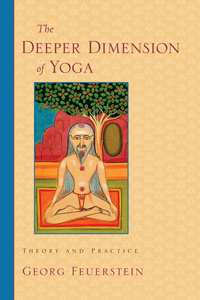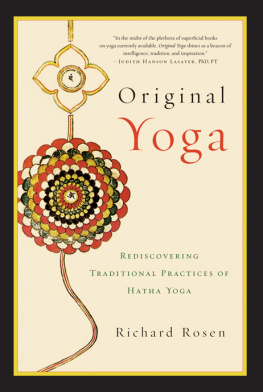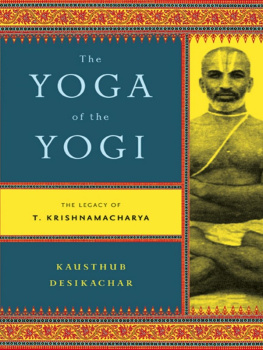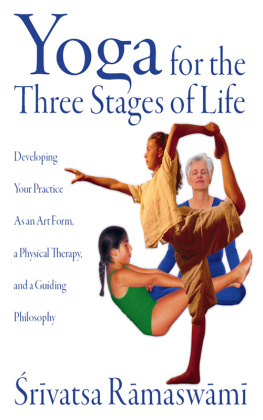Krishnamacharya
His Life and Teachings
A. G. MOHAN
with Ganesh Mohan

SHAMBHALA
Boston & London
2011
Shambhala Publications, Inc.
Horticultural Hall
300 Massachusetts Avenue
Boston, Massachusetts 02115
www.shambhala.com
2010 by A. G. Mohan
All rights reserved. No part of this book may be reproduced in any form or by any means, electronic or mechanical, including photocopying, recording, or by any information storage and retrieval system, without permission in writing from the publisher.
Library of Congress Cataloging-in-Publication Data
Mohan, A. G. (Angarai Ganesha), 1945
Krishnamacharya: his life and teachings/A. G. Mohan with Ganesh Mohan.1st ed.
p. cm.
eISBN 978-0-8348-2249-8
ISBN 978-1-59030-800-4
1. Krishnamacharya, T., b. 1888. 2. YogisIndiaBiography. 3. Yoga.
I. Mohan, Ganesh. II. Title.
BJ1175.K723M65 2010
294.5092dc22
[B]
2010008662
I WAS A YOUNG BOY when my father studied with Krishnamacharya. I viewed Krishnamacharya with considerable awe, though he was always approachable and encouraging on the occasions I was in his presence. My memories of him are sweetened, perhaps, by his giving me sweetened almonds when I would see him!
This book is narrated from the perspective of my father but through my writing. I would ask my father about his experiences with Krishnamacharya, think over how best to express his recollections, and then put them down in writing. After that, we would go over the material and edit it. Having been involved in yoga and other traditional Vedic studies from childhood and having memories of Krishnamacharya (albeit through the eyes of my young self) made it easy for me to relate to my fathers experiences.
Krishnamacharyas language of expression in traditional studies was Sanskrit, and he used many Sanskrit words to describe asanas and methods of practice. We use some of these terms throughout the book to give readers a flavor of the context in which my father studied. Just as contemporary yoga teachers and students need not learn all the Sanskrit terms that apply to the practice of yoga, we do not expect readers to struggle with these terms. Learning Sanskrit words associated with yoga is not nearly as important as understanding the subject and how to apply it.
Krishnamacharya taught on so many diverse subjects that this book would have to be immense to do justice to his entire teachings. As we worked on the book, we found it necessary to redefine its scope and start over, more than once. This project has taken us about two years to complete. We finally settled for a book that covers a variety of topics. It presents information about Krishnamacharyas life as well as a portrait of his persona as a teacher and as a practitioner of yoga. The book also contains highlights of Krishnamacharyas teachings on the spectrum of yoga studies and a description of his works, including a summary of the major ones. Working on this book gave me the opportunity to listen to my fathers audio recordings of Krishnamacharyas lectures and chanting, as well as to recordings of the few interviews the master gave. We have released some recordings of Krishnamacharya chanting, with my father, in the form of a nonprofit CD titled The Masters Voice.
My family was dedicated to Krishnamacharya and his teachings even before I was born. My mother, Indra, has been part of this project at every step. A serene practitioner and patient teacher of yoga (as her numerous dedicated students will attest), she has been my fathers primary support in his spiritual journey over the decades. My sister, Nitya, has given us valuable input, too. Being older than I am, she has a clearer memory of Krishnamacharya. In addition to practicing and teaching yoga, she is an accomplished singer and is perhaps one of the few people to have met the masters exacting standards for chanting and to have received praise from him for it.
My gratitude is also due to Patty Moynahan; her editing has improved the text immensely. She brought to this project not just her skill as a writer but also considered evaluation and thoughtful appreciation of the subject, and involvement from the heart.
It has been my privilege to work with my father on this book.
GANESH MOHAN
I MET MY GURU, Sri Tirumalai Krishnamacharya, nearly forty years ago and studied with him for almost two decades. He was unparalleled in many waysas a master of yoga, as a teacher, as an Ayurvedic/yogic physician, and as a scholar. If yoga is so widely popular now, it is in no small measure due to his practice, his brilliance, his depth of knowledge, and his tireless perseverance in propagating ancient wisdom.
Yet many yoga practitioners know little about Krishnamacharya as a person or about his teachings. One reason for this is that during his lifetime, Krishnamacharya had no regard for personal publicity or material success. As a student, the one virtue I can claim credit for was my resolve to study with Krishnamacharya until the end of his life, regardless of any problems I might face in mine. I also had the privilege of serving Krishnamacharya personally in his last years. This book presents the rare relationship I had with a unique master; it is my tribute to Krishnamacharya as my teacher.
I have had the good fortune to meet and spend time with many yoga masters over the yearssometimes when they visited my guru and sometimes personallyincluding other students of Krishnamacharya, such as B. K. S. Iyengar and Indra Devi, or yoga luminaries like Swami Satchidananda. In this book, however, I have intentionally refrained from narratives that digress from the life and teachings of Krishnamacharya and from my reflections as his student.
One of Krishnamacharyas favorite sayings can be approximately translated as a capable student brings fame to the teacher. Yet Krishnamacharyas humility always led him to discourage writings that praised him. In accordance with his preference, this book is simple and direct, with no embellishment; however, no exaggerations are required to bring to light the greatness of such a master as Krishnamacharya. Honoring his endeavor to propagate yoga, I have not merely narrated a story but also highlighted the message that he brought forth through his life and conduct.
For me, writing this book has been a journey back to the treasured days of my studies with my guru. I sincerely hope that as a student or teacher of yoga, or as a reader simply interested in knowing about Krishnamacharya, you will find this book valuable.
A. G. MOHAN
 1
1 
T IRUMALAI KRISHNAMACHARYA was born in November 1888 in the village of Muchukundapuram, which is in the South Indian state of Karnataka. His father was Srinivasa Tatacharya and his mother, Ranganayakiamma. His great-grandfather was Srinivasa Brahmatantra Swami, the head of the Parakala Math in Mysore, one of the ancient and respected religious institutions in the Vaishnavite tradition. Vaishnavism is among the most prevalent traditions of Hinduism. Its name derives from the emphasis it places on devotion to the Divine in the form of the deity Vishnu, also known as Narayana.
As a child, Krishnamacharya was trained in the study of the Vedas, initially by his father, as was the custom in an orthodox Brahmin family of those times. The Vedas are the ancient body of knowledge that forms the basis of what is now known as Hinduism. When Krishnamacharya was around twelve years of age, he continued his studies at the Parakala Math and at the university in Mysore. He learned Sanskrit as well as aspects of Vedic knowledge, like
Next page







 1
1